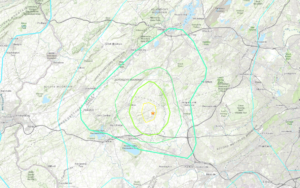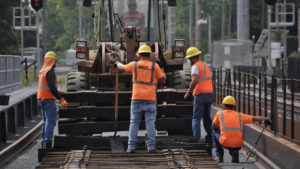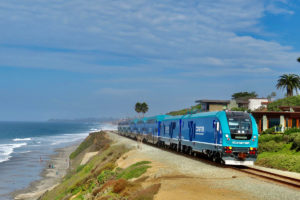Union Pacific alters tunnels so double-stack trains can reach Reno
Written by jroodUnion Pacific has raised the roof on 15 of its tunnels over Donner Pass in the Sierra, allowing double-stacked trains to cross the pass and go through Reno for the first time on the way to Chicago, the Reno Gazette-Journal reports. When the recession ebbs, more trains could be coming through Reno and Sparks. Double-stacked trains have been routed through the longer and more difficult Feather River Canyon north of Reno.
In a way, former Reno Mayor
Jeff Griffin can consider himself redeemed for pushing to build the downtown
railroad trench, completed in 2005 at a cost of $282 million. In the late
1990s, Griffin often said the day would come when the tunnel roofs would be
raised for cars carrying double-stacked cargo containers from Pacific Rim and
Asian countries unloaded at the Port of Oakland.
"It took a little longer
than I thought," said Griffin, who ran an international shipping business in Reno
for years and recently saw his first double-stacked train on the route east of
Fernley. "I just know that it was a business decision a multi-billion company
had to make."
While Griffin predicted the
number of trains a day would jump substantially, critics railed against city
plans to build a railroad trench and eliminate crossings in downtown. But the
city hasn’t gone bankrupt as feared because of trench cost overruns, nor has
the trench been destroyed by floods or earthquakes.
Tom Lange, UP western spokesman,
said 15 to 18 trains a day are routed through Reno, about the same as before
the tunnels were finished in late November. He said there is no way of telling
how many more trains will be coming.
"Our volume is based on the
economy and customer needs," he said. "There’s not really a way to project
future transportation volume."
Union Pacific spent about
$2.6 billion in the past year to improve its rail system while business was
slow because of the recession.
Donner Pass is about 75
miles shorter and up to three hours faster than the Feather River Canyon route,
making it the shortest route between Oakland and the railroad hub of Chicago.
Double-stacked trains can be as long as 9,000 feet and cross Donner Pass while
the length of trains are limited to 5,700 feet on the winding Feather River
pass.
Keeping both routes open
allows for more flexibility, said John Kaiser, UP vice president and general
manager. The Feather River route is used for slower trains with a variety of
cars such a tanks and flatbeds.
Griffin said
industrial/warehouse distribution businesses in Reno and at the Tahoe Reno
Industrial Center in Storey County would benefit from cheaper double-stacked
train service.
Lange said the railroad
also will have some crews based in Sparks instead of Portola, Calif., as a
result of the route changes while support staff will remain in Portola. He said
double-stacked trains take trucks off the road. UP said a train can take up to
300 long-haul trucks off of Interstate 80, helping to reduce traffic congestion
over the pass and through Reno and Sparks. And that helps reduce pollution. UP
claims it can move a ton of goods 830 miles on a gallon of diesel fuel.
But more trains eventually
could cause delays for residents in River Park on the west edge of Reno who
must cross tracks to get home. East of downtown, trains also would block
traffic on Sutro Street but motorists have the Wells Overpass as an
alternative.
Before UP purchased
Southern Pacific Railroad in 1996, UP officials recognized the port’s role in
its future and said it planned to eventually enlarge the tunnels over Donner
Pass to carry goods to Chicago. In the merger, federal authorities singled out
only Reno and Wichita, Kan., for special consideration. To build the downtown
trench, Union Pacific contributed $35 million and 165 acres of usable land.
The federal Surface
Transportation Board predicted up to 25 trains a day would run through Reno,
compared with an average of 14 trains before the merger.





